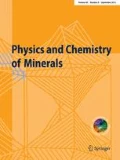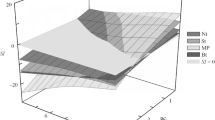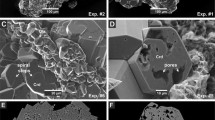Abstract
The transformation of struvite MgNH4PO4 · 6H2O into newberyite MgHPO4 · 3H2O is studied in aqueous solutions at 25° C and 37° C by following the evolution of solutions, supersaturated with respect to both phases in the concentration range 0.025–0.50 M. The precipitation of struvite as the first phase is accompanied by a sharp decrease of pH, which subsequently remains constant. During this period, newberyite crystals can nucleate whereas struvite is dissolving. Another decrease of pH, due to the newberyite growth, is observed when almost all struvite has disappeared. Finally pH tends asymptotically to a constant value, corresponding to a stable equilibrium. The whole process may take several months. At neither stage were epitaxial relationships observed between struvite and newberyite. The shape of the newberyite crystals is an indicator of their origin in mineralogical and biological systems.
Similar content being viewed by others
References
Abbona F, Boistelle R (1979) Growth morphology and crystal habit of struvite crystals (MgNH4PO4 · 6H2O). J Crystal Growth 46:339–354
Abbona F, Boistelle R, Lundager Madsen HE (1982) Crystallization of two magnesium phosphates, struvite and newberyite: Effect of pH and concentration. J Crystal Growth 57:6–14
Boistelle R, Abbona F (1981) Morphology, habit and growth of newberyite crystals (MgHPO4 · 3H2O). J Crystal Growth 54:275–295
Bridge PJ (1971) Analyses of altered struvite from Skipton, Victoria. Mineral Mag 38:381–382
Cohen LH, Ribbe PH (1966) Magnesium phosphate mineral replacement at Mono Lake, California. Am Mineral 51:1755–1765
Frazier AW, Lehr JR, Smith JP (1963) The magnesium phosphates hannayite, schertelite and bobierrite. Am Mineral 48:635–641
Gragg R (1928) Newberyite and other phosphates from Ascension Island. Am Mineral 13:397–401
MacIvor RWE (1970) Über die Mineralien des australischen Fledermausguanos. Z Kristallogr 42:386–387 (Auszüge)
Lacroix A (1912) Sur les minéraux du guano de la Réunion. Bull Soc Franç Minéral 35:114–119
Ribbe PH (1969) The decomposition of struvite: further evidence. Mineral Mag 37:290
Schmidt A (1883) Newberyite von Mejillones, Chile. Z Kristallogr 7:26–35
Schulten A de (1903) Recherches sur la struvite et la struvite arséniée artificielles. Production simultanée de la struvite et de la newberyite, de la struvite arséniée et de la roesslérite. Bull Soc Franç Minéral 26:95–98
Sücker I (1963) Magnesiumhydrogenphosphat als Bestandtheil von Harnkonkrementen. Naturwissenschaften 50:499–500
Taylor AW, Frazier AW, Gurney EL (1963) Solubility products of magnesium ammonium and magnesium potassium phosphates. Trans Faraday Soc 59:1580–1584
Whitaker A (1968) The decomposition of struvite. Mineral Mag 36:820–824
Author information
Authors and Affiliations
Rights and permissions
About this article
Cite this article
Boistelle, R., Abbona, F. & Lundager Madsen, H.E. On the transformation of struvite into newberyite in aqueous systems. Phys Chem Minerals 9, 216–222 (1983). https://doi.org/10.1007/BF00311958
Received:
Issue Date:
DOI: https://doi.org/10.1007/BF00311958




